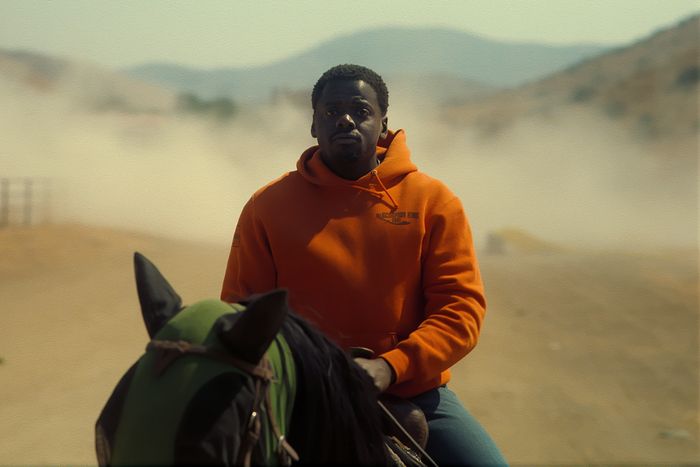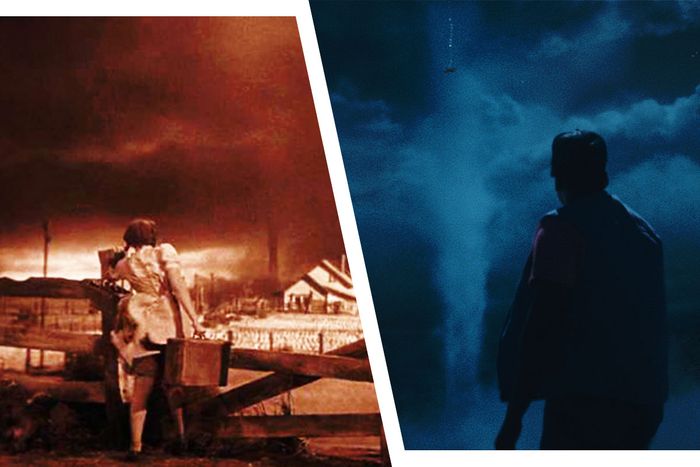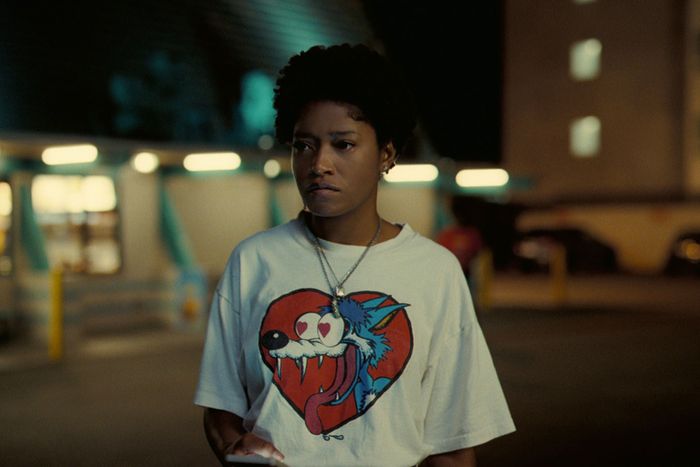
Spoilers ahead for Nope.
Jordan Peele is in Twilight Zone mode on Nope. For his third feature film, the writer-director spins a tale of high strangeness in inland California that doubles as a deconstruction of the summer blockbuster and triples as a parable — either about Hollywood or about humanity’s relationship with nature, depending on who you ask. (Maybe a little of both?) Early teasers for the film hinted that UFOs would be a key element of the story, and Nope more than delivers on that promise. Over the course of this 135-minute sci-fi adventure, the extraterrestrial force terrorizing the remote valley of Agua Dulce gradually reveals more of itself, going from a subtle shadow to a fully unfurled intergalactic flower-squid.
The film evolves as well, shifting from comedy to horror to blockbuster spectacle as it follows siblings O.J. (Daniel Kaluuya) and Emerald Haywood (Keke Palmer) and their attempts to save the family business, Haywood’s Hollywood Horses, by capturing and selling photographic proof of alien life. And although Nope is a less cryptic work than Peele’s last film, 2019’s Us, it still leaves a bread-crumb trail of influences and Easter eggs to enrich the experience for observant viewers.
The Gordy’s Home Massacre
Gordy’s Home is obviously not a real sitcom, but the idea of an otherwise friendly chimpanzee randomly attacking his human co-stars is not out of the realm of possibility. A chimp can straight-up rip your face off if properly provoked — take the case of Travis, a chimpanzee with a robust commercial résumé who made international headlines after he grotesquely mauled Charla Nash, a longtime friend of his owner, in 2009. (It’s unclear why Travis attacked Nash, whom he knew well; possible triggers include Nash’s new haircut, the Xanax in Travis’s system, and Nash holding one of the ape’s favorite toys.) Nash underwent facial reconstructive surgery after the incident, but doctors were unable to restore her eyes. Nash revealed her disfigured face on The Oprah Winfrey Show in November of that year, in a hat and veil very similar to the one an adult Mary Jo Elliott wears to Jupiter’s Claim in the film.
The Horse In Motion
The Haywoods’ assertion that the first motion picture featured a Black man on a horse, and that the jockey in the film remains unidentified to this day, is mostly correct. Pedants can quibble over whether the three-second clip in question is actually the first moving picture — photographer Edward Muybridge shot multiple series of photographs capturing a galloping horse’s gait in 1878, and it’s unclear which of them was executed first. But it’s definitely part of the first batch of moving pictures. And the man in the clip is indeed anonymous: We know the name of the horse (Annie G) but not the jockey, a troubling reflection of the erasure of Black horsemanship in history. We also know that horse racing was one of a scant few paths to upward mobility for Black men in the late 19th century, although the racist condescension lobbed at jockeys made their success a mixed proposition.
Buck and the Preacher
One of the many movie posters hanging in the Haywood family home is for the 1972 western Buck and the Preacher, directed by Sidney Poitier and starring Poitier and Harry Belafonte in the title roles. The success of Lil Nas X has sparked a renaissance of pride in Black cowboy culture, but this is hardly the first surge of interest in the phenomenon: The confluence of Black Power and Blaxploitation led to a wave of Black westerns in the early- to mid-’70s, of which Buck and the Preacher is a prime example. (Thomasine & Bushrod, directed by Shaft’s Gordon Parks Jr., is another standout.) In a bit of serendipitous timing, a 4k restoration of the film hits Blu-ray via the Criterion Collection in August.
EMPs
The being over the Haywood ranch announces its presence by emitting a signal that shorts out all electronic devices within a several-hundred-yard radius, an extraterrestrial version of the phenomenon known as electromagnetic pulses (EMPs). More scientific minds than these can explain how EMPs actually work (something to do with gamma radiation?), but they can either be organic — think solar flares and geomagnetic storms — or manmade. They’re also a popular buzzword in the conspiracy-theory and doomsday-prepper communities, the latter of whom stock up on battery-operated everything to prepare for a world where every electrical grid and digital archive has been wiped out by a weaponized EMP deployed by sinister forces — the Russians, the Chinese, aliens, Antifa, the sun, whatever.
The Wizard of Oz
Another signature move of the Haywood phenomenon is cyclones of swirling dust that suck up everyone and everything in their path before belching out the indigestible metal and plastic bits hours, or even days, later. This combines the strange but natural phenomenon of weird shit raining from the sky (cyclones are to blame there too) with a hint of The Wizard of Oz, whose influence is especially noticeable in a shot where O.J. stands in front of the Haywood family home — a humble, isolated farmhouse, much like the one where Dorothy Gale lived — watching the oncoming twister as the sky turns dark above him. Sadly, however, the only thing waiting for you on the other side of the rainbow in Nope is a terrifying, painful death in an alien’s esophagus.
“The Navy Clip”
If the United States government’s goal really is to minimize mass panic about the existence of extraterrestrials, it did a good job by dropping a casual “BTW, UFOs are totally real” amid the chaos of the Trump years. In 2017, the New York Times reported on a Department of Defense project called the Advanced Aerospace Identification Program, which was backed (and its existence confirmed) by former Senate majority leader Harry Reid. Around that same time, the Navy and Air Force changed the official terminology from UFOs to UAPs, or “unidentified aerial phenomena.” From there, the disclosures began tumbling out: First, the U.S. Navy confirmed the veracity of footage of three separate encounters between Navy pilots and mysterious flying objects originally leaked by former Blink-182 guitarist Tom DeLonge’s company, To the Stars — the “Navy Clip” Angel Torres (Brandon Perea) mentions in Nope. With most of the world was too preoccupied with earthbound nonsense to notice, the Pentagon officially declassified and released the “Navy Clip” in 2021, and a House hearing in May 2022 reported that while the Navy now has more than 400 official reports of UAPs in its database, none of them were “non-terrestrial in origin.” Sure.
Ancient Aliens
Angel gets a lot of his information about UFOs (sorry, UAPs) from the History Channel series Ancient Aliens, a long-running “documentary” repository for all manner of pseudoscientific bullshit. More than 212 episodes spread across 18 seasons, Ancient Aliens has uncritically explored such questionable phenomena as hollow-earth theory, crystal skulls, remote viewing, cataclysmic pole shifts, and multiple flavors of creationism. But its primary cash cow is the “ancient astronauts” theory, which posits that sometime in the deep past, aliens visited Earth and mated with homo sapiens, sharing their expertise in engineering, mathematics, writing, and architecture and inspiring global mythologies about gods descending from the heavens to give knowledge to humanity. The “ancient astronauts” theory is racist gibberish, of course, summed up — as so many things are in 2022 — by the meme above. Ancient Aliens is still fun to watch when you’re high, though.
O.J.’s The Scorpion King hoodie
O.J.’s first real job as an animal trainer was on 2002’s The Scorpion King, a spin-off of the ’00s Mummy series that also happened to mark the first starring film role for one Dwayne “The Rock” Johnson. Being a humble, practical sort, O.J. has hung on to his official Scorpion King crew sweatshirt for the past 20 years, and wears it for his heroic final confrontation with the creature at the end of the film. Again, it’s a practical choice: The hoodie is bright orange, which will make him easier to see, and it reminds O.J. of his dad, which will give him strength. More generally, movie swag is having a moment: Last November, A24 published a coffee-table book called For Promotional Use Only that rounds up decades’ worth of odd and amusing promotional items, the most coveted of which are the commemorative jackets, shirts, and so on typically distributed to crew members on big Hollywood movies at the wrap party.
The Jesus Lizard
Nope features multiple band T-shirts, a motif that’s of a piece with the movie’s affection for promotional movie gear. The most on point of these is the Jesus Lizard T-shirt that Angel lends to Emerald when she and O.J. flee the family homestead late in the film. The long-running Chicago noise-rock group doesn’t have any songs that are specifically about aliens (although it does have one called “Monkey Trick”). But its name is a reference to the basilisk lizard, nicknamed “the Jesus Lizard” for its ability to walk on water. Or, if one puts on one’s tinfoil hat, one could also see it as a nod to the idea that America is secretly ruled by a race of extraterrestrial lizard people, as popularized by the conspiracy theorist David Icke. With that in mind, you can combine the three band shirts featured in the film into a semi-coherent message: “Earth, the Jesus Lizard! Rage against the machine!”
“The Purple People Eater”
Jordan Peele has a thing for deploying slowed-down music in his films — and, to be fair, he’s better at it than most. Nope doubles the unease with a half-speed version of “Sunglasses at Night” by Canadian ’80s two-hit-wonder Corey Hart, followed by a solemn recitation of the ’50s novelty song “The Purple People Eater” around the Haywood family dinner table. “The Purple People Eater” was a hit for songwriter Sheb Wooley in the summer of 1958, eventually selling more than three million copies and topping the Billboard pop chart for more than a month. Unlike Nope’s malevolent creature, the Purple People Eater itself is nothing to fear: It only eats purple people, you see, and considers the rest of us too tough to chew. But it is down to drink tequila and play rock and roll out of the single horn on top of its head, which is pretty chill.
Arrival
The influence of Arrival is most visible in the design of Nope’s spacecraft/super-predator, whose input duct/esophagus combines the organic and the industrial in a way that recalls the alien visitors’ ships in Denis Villeneuve’s 2016 sci-fi film. (Shadowy, squidlike aliens and low booming tones recur in both films as well.) And once the true nature of the being is revealed, O.J.’s attempt to communicate with it in terms it can understand also evokes that film’s exploration of the nuances of interplanetary linguistic contact. The dynamics are calibrated differently — Peele turns down the creature’s intelligence and turns up the threat — but both films are fixated on similar questions about what alien life might look like and what it might want from us.
Steven Spielberg
That being said, the most prominent cinematic influence on Nope is not a single film, but the work of a director: Steven Spielberg, king of the summer blockbuster. Now, Peele doesn’t copy Spielberg’s style as literally as some (looking at you, J.J. Abrams). But the film does borrow structural and character elements from Jaws, particularly once grizzled, obsessive cinematographer Antlers Holst — the Quint of the piece — joins the hunt. And the revelation that the creature won’t eat you if you don’t look it in the “eyes” is reminiscent of Jurassic Park, which similarly builds tension out of the idea that a T. rex can’t see humans if they remain perfectly still. There’s also an overall mood of sweeping adventure in the film’s final act that’s very much in the Spielberg spirit — and a few kids get into some serious peril, too.
More on 'Nope'
- The Last of Us Nominated for Best Kiss at MTV Movie & TV Awards
- Oscar Futures: Is the Academy Ready to Forgive Will Smith?
- Keke Palmer’s Nope Press Tour Deserves an Archive



